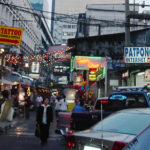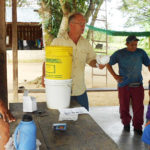SAN LUIS, Peru (BP)—Josh Murphree doesn’t live at the ends of the earth, but Murphree jokes he can see it from his back porch.
It’s no joke trying to get to San Luis in the Ancash region of Peru, where he and his wife, Crystal, live with their two children, Ella and Isaac. Driving to the town deep in the Conchucos Valley from Peru’s capital of Lima entails crossing a mountain range on perilous roads and traversing a 16,043-foot pass.
 Location of St. Louis, Peru. (Google Maps Image)Like the overwhelming obstacles the mountains can be, life in this remote mountain setting has its share of struggles, Murphree said.
Location of St. Louis, Peru. (Google Maps Image)Like the overwhelming obstacles the mountains can be, life in this remote mountain setting has its share of struggles, Murphree said.
“It’s been tough to homeschool. We have been very lonely at times. We’re eight hours away from an ATM or restaurant that won’t make us sick,” said Murphree, a Southern Baptist missionary. “It’s been tough but very rewarding at the same time. We realize we’re right in the middle of where God wants us to be—even if it’s not the safest place or the easiest place.”
Murphree has hiked over mountains, taken hours-long bus rides and crossed some risky bridges to reach villages that need the gospel.
The Northern Conchucos Quechua live in this geographically demanding area that provides plenty of obstacles hampering the spread of the gospel. Catholicism in the region has been fused with indigenous animistic beliefs, and evangelical Christians are hard to find.
Five rediscovered Baptist churches
In 2012, student researchers for the Ancash Quechua team—of which the Murphrees are a part—discovered a cluster of five small Baptist churches in the remote Huánuco region. Team leader John Grady learned the fellowships may date back to a Foreign Mission Board missionary who traveled into the area by horseback about 20 years ago and led several people to Christ. In the intervening years, the fellowships stayed true to Scripture, in part because some members in the congregation could read the Spanish-language Bible.
Those five churches are among the few that have not slipped into heresy, Grady said.
Sign up for our weekly edition and get all our headlines in your inbox on Thursdays
“A lot of pastors can’t read the Bible and have dismissed it as old news,” he said.
On the edge of the rainy season later that year, Grady, Murphree and another colleague made a trip into Huánuco to teach and train there. They traveled in a four-wheel-drive truck instead of on horseback, as the earlier missionary had done before roads were built in the area. The villages seemed cut off from the outside world in the rugged terrain high above the Marañón River, Murphree said.
“It was amazing to experience a culture that did not depend on outside trade but only from their own crops,” he said. “At the elevation where we stayed, most of the people grew potatoes and cold-weather crops, but it was possible on clear days to turn around and see snow in the mountains right behind us.”
20 years of questions
When they arrived, Murphree said, they discovered Christians “with 20 years of questions in the making.” For six days, they met with the churches, first in the main town of Huacrachuco, and then journeyed to outlying villages to teach in other fellowships, some of which could only be reached on foot. Many came into the villages from even further out in the mountains in spite of the rains. Several times, the missionaries spoke to packed houses. In one village without electricity, they taught into the night by lantern light.
“We were able to spend some time with leaders in the churches, teaching oral means of sharing the gospel in Quechua through stories,” Murphree explained. “The leaders in the churches were thrilled to learn how to take stories from the Bible in Spanish and craft stories in their own heart language to be shared with those who only speak Quechua.”
When it was time to depart, the missionaries discovered a mudslide had destroyed a bridge on their return route. Since there was no alternative route, road workers placed logs across the gully over which Grady carefully drove their vehicle. Murphree and other colleagues volunteered to cross on foot.
Crafting Bible stories
The Ancash Quechua team is working with nationals to craft stories from the Bible into Quechua to meet the needs of Christians in the mountains and to enable believers to share the truths of the Bible in the heart language of the Quechua people.
“So we realize we’ve got to put a lot of our effort into Bible storying … teaching the stories to outreach groups and house churches, helping them to multiply our efforts,” Murphree said. The leaders of these small groups are excited about the teaching method.
“Rather than preaching on a few verses, they said: ‘I’m going to learn these stories and tell people what the Bible says. I want to tell people what God’s word says. They’ll understand it this way.’”














We seek to connect God’s story and God’s people around the world. To learn more about God’s story, click here.
Send comments and feedback to Eric Black, our editor. For comments to be published, please specify “letter to the editor.” Maximum length for publication is 300 words.